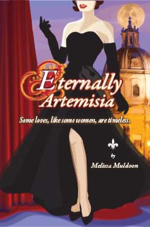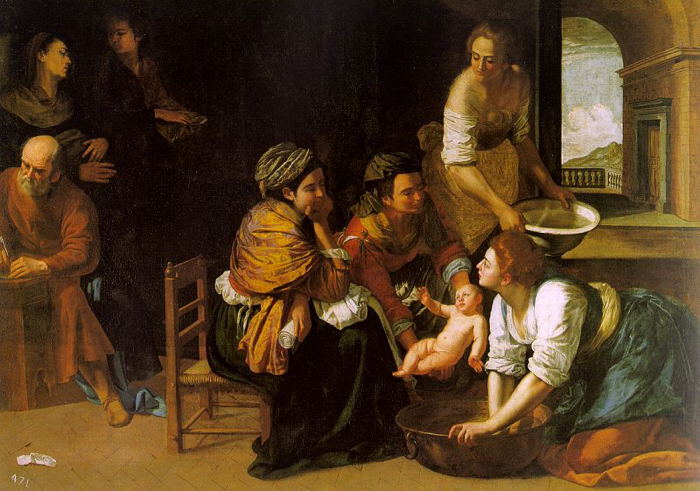by Melissa Muldoon
As I was finishing my second novel, Waking Isabella—a story set in Arezzo, Italy that tells the story of Isabella de’ Medici and her portrait that was lost during World War II—I realized I didn’t want my writing experience to end.
So, before I had even published my second novel I was already thinking about a topic for a third one.
It didn’t take long, and the subject came to me as I was driving home from the gym one afternoon.
I Wanted to Write About One of the First Major Female Painters of the Baroque Era
I typically get my best ideas after working out or when I walk the dogs during the evening hours. As I was waiting for the light to change at an intersection I cast about for ideas, and it came to me—I wanted to write about Artemisia Gentileschi, one of the first major female painters of the Baroque era. At the next stop light, I already had an idea for the title.
From the first day I was introduced to Artemisia in a darkened lecture hall in college, I have been fascinated and intrigued by this seventeenth-century artist’s story. Raped by her painting instructor at the age of 16, Artemisia took Agostino Tassi to court, not for the crime of molestation, but because he stole a picture from her and reneged on his promise to marry her after he violated her.
In a time when it was unheard of for a woman to accuse her rapist publically, Artemisia did, but in the end, she suffered great indignities and torture to prove that she was the one telling the truth. In the end, she won her case, but her life was in tatters. Her rapist, however, never spent a day in jail.
While this experience, especially at such a young and vulnerable age, might have devasted most people, Artemisia had the spirit and the talent to pick herself up from the ashes and re-invent herself. She went on to become the protegee of Cosimo II de Medici in Florence, friend to Galileo, and painted for Dukes and Kings all over Europe and England.
I Wrote About a Female Painter Who Was Raped, Yet Had the Courage to Persevere in a Male-Dominated Profession
Artemisia used her art to heal herself, throwing herself passionately into her work, even painting images of herself and her rapist in her biblical scenes to work through the myriad of emotions such violence causes a woman.
Artemisia was also very astute, and despite being illiterate, living on a shoe-string budget, and being married off to a philandering man by her father to save her reputation, Artemisia succeeded in a male-dominated society in Florence to become a notable painter.
The Grand Duke of Tuscany regarded her so highly he admitted her into the elite previously all-male Florentine Art Academy. She was the first woman to shatter the glass ceiling of the art world in her day and age.
To me, Artemisia’s story is one that shouldn’t be forgotten and is relevant today. When we find what we are most passionate about, and we are determined and believe in ourselves, there is nothing we can’t accomplish.
How the Idea of Time Travel Helped Me Weave My Story Together
Eternally Artemisia is an intricately plotted novel that blends the past with the present. As in my first two novels, I bring to life contemporary protagonists as well as historical characters from the seventeenth century. Since the story weaves together many ideas, it was quite a challenge to balance them all and keep all the many threads of my story from tangling.
First and foremost, I wanted to communicate Artemisia’s story—but I wanted her to speak to my reader’s in her own voice. To do so, I needed to bring her to life as a fully-fledged character living in her own time.
I also wanted to create a contemporary character—my twenty-first protagonist Maddie—who could speak to the problem of violence against women in the modern age as well as the restorative powers of art therapy.
So, to keep the reader moving through different centuries to the present age, I introduce the theme of time travel. I explore the idea that people who are intensely connected are destined to meet over and over again over time. With each new re-incarnation, they meet for the first time and recognize one another instinctively.
One Challenge in My Novel: Balancing the Topics of Sexual Violence and the “Me Too” Movement
It was a challenge and a joy, not only to develop and flush out Artemisia’s character as a sympathetic protagonist, but also to create the different versions of Maddie to fit the various periods she inhabits throughout the book.
She assumes the personalities of an Art Therapist, a fashion designer, a Venetian courtesan, and several other personas—but always her character takes the form of a strong, inspirational woman, who draws her courage from Artemisia’s role model.
Another challenge I encountered while writing my novel was balancing the weighty topics of sexual violence against women and the “Me Too” movement. I speak to the fact that while many things have changed in the last five-hundred years since Artemisia’s trial, women still face many of the same barriers and sexual abuse today as did my seventeenth-century heroine.
I also talk to the point that when united, women can empower one another and through shared experiences start to recover and heal from sexual abuse.
How My Editor Helped Me See that My Story was Unbalanced
After working extremely hard on the outline and spending months on the first draft, as I did with my first two novels, I send it out to a story editor to get feedback and to find out where my story was working and where it was going off the rails. Before I heard back from my story editor, I was feeling quite pleased with what I’d written up to that point.
It is always a bit of a pill to swallow to read the first round of criticism.
In the case of Eternally Artemisia, my eyes were opened to the fact that my story was very unbalanced. I had spent far too much time talking about the women’s retreat, art therapy, and violence against women. My novel had become a bit too preachy and heavy-handed. I lost the thread of time travel so that when I returned to that theme, it seemed out of place as if I was telling a different story altogether.
At this point, a decision needed to be made. I would either toss my work into a drawer and forget about it… or I would get a good night’s sleep, suck it up and start over again the next day.
And that is what I always do. I take some time to think through what it is I want to accomplish with my story. Then, I go through each and every one of my editor’s comments and begin to rewrite my story all over again.
Your First Draft is Only a Blueprint
I found the second time around the writing was much better, and the process a lot easier because I’d actually done all the groundbreaking work. As I began again, I knew where I was going—I wasn’t feeling my way in the dark anymore.
I’d become friends with my characters, and I knew more about them. I knew their hopes, dreams, and aspirations, what they felt and would be more likely to say. With new confidence and fore-knowledge, I was better able to “show rather than tell,” and fine-tune their dialogues.
I must always remind myself that the first draft is only a blueprint, not the final book and not beat myself up for not writing the perfect story right out of the gate. It is all part of the process that I must go through—to arrive at the end and start over again.
The story is richer because of this because I can add interesting details that I discover about the story into foreshadowing in the earlier chapters and embellish and enhance certain plot points.
The Moment of Triumph: When I Decided How My Book Should End
I think the moment of triumph came when I decided how my book should end.
At first, I had written a rather tame, predictable ending. But, when I sat back and realized really what kind of story I’d actually written, and what it meant to women, I realized I needed to “break up” with the first version ending.
It was a difficult moment and a little scary to toss it aside and launch into new territory and create a totally unexpected finish to my book. But, once I let go of my inhibitions and sat down and pounded it out—when I typed the last word, I knew I couldn’t end my story any other way.
It was in that moment I knew my story finally made total sense, and I had ended up telling the story I set out to tell.
Writing Allows Me to Blend All My Creative Talents
Being an author—on top of a being a graphic designer, illustrator and Italian language blogger—has opened up a whole new chapter in my life.
I find the process of writing thoroughly invigorating and satisfying because I am able to blend all my creative talents. And with each new book I produce, I become more a more proficient and confident writer.
My first two books are dear to me, but I think this third novel is my best work yet because of this. And now I can’t wait to begin work on a new idea!
I already miss the creative process—I miss blending history with contemporary characters and building images and new worlds with my words.
The “Zone” That I Fall Into When Entering My Creative Space Seems Inexplicably Mystical
For me, writing a novel is a very creative process. I find it to be a highly enjoyable act that involves all my mental capacities and energy.
Through the writing process, I am able to give in and let go of my temporal existence and enter into a new realm—okay, let’s call it spiritual. By freeing my mind, I am able to tap into parts of myself I never knew existed. As a result, without thinking too hard, some of my best lines and paragraphs just seem to write themselves and I am able to express and communicate my deepest private thoughts.
The process is calming, exhilarating, cathartic and freeing. It is also fully consuming. I don’t fully understand entirely this “zone” that I fall into when I enter my creative space, but, by giving in to it, to me, it seems inexplicably mystical and totally joyful.
Advice for a Young Writer: Be Kind to Yourself
Writing a novel is hard work. It isn’t for the faint of heart. It requires a highly creative idea that only you can tell in your own way and in your own words.
It also requires the ability to disassociate yourself from the novel you thought you wanted to write and write the story your characters start to dictate—you know the story that is really inside of you that begins to flow onto your page without you even realizing it.
It also requires you to have the ability and resolve to tear apart your work over and over again to make it better. It takes the clarity of mind to accept criticism and the willingness to correct your work when you go off the rails.
Because of this, the writing process can be time-consuming, tedious, and disheartening. At times it can make you question whether you are a good writer.
But be kind to yourself. Especially if you are a perfectionist like me. Just know that after a good night’s sleep everything looks better in the morning and you will have a clearer vision. So, don’t procrastinate. Instead, find the fire inside of you and keep at it. Remember—you don’t have to write the perfect story the first time around. You can always fix a badly written paragraph, but you can’t fix one that isn’t written.
Also, I don’t believe in writer’s blocks. I think writer’s block is the result of not knowing what you want to communicate in the first place. When this happens, you have to go on long walks, listen to good music and re-center yourself. You must figure out what is the point or big idea you want to convey. Be open to self-revelation. When you do, the ideas will come to you when you least expect them.
Then going forward, you have to keep asking yourself at every point in the story, what do my readers need to know next? That will answer the question of how you should proceed with your next chapter and keep your story flowing until the very last word.
* * *
 Melissa Muldoon is the author of three novels set in Italy: Dreaming Sophia, Waking Isabella, and Eternally Artemisia. All three books tell the stories of American women and their journeys of self-discovery to find love, uncover hidden truths, and follow their destinies to shape a better future in Italy.
Melissa Muldoon is the author of three novels set in Italy: Dreaming Sophia, Waking Isabella, and Eternally Artemisia. All three books tell the stories of American women and their journeys of self-discovery to find love, uncover hidden truths, and follow their destinies to shape a better future in Italy.
Melissa is also the author of the Studentessa Matta website, where she promotes the study of Italian language and culture through her dual-language blog written in Italian and English (studentessamatta.com). Studentessa Matta means the “crazy linguist” and has grown to include a podcast, Tutti Matti per l’Italiano and the Studentessa Matta YouTube channel, Facebook page and Instagram feed. Melissa also created Matta Italian Language Immersion Programs, which she co-leads with Italian schools in Italy to learn Italian in Italy. Through her website, she also offers the opportunities to live and study in Italy through Homestay programs.
Melissa has a B.A. in fine arts, art history and European history from Knox College, a liberal arts college in Galesburg, Illinois, as well as a master’s degree in art history from the University of Illinois at Champaign-Urbana. She has also studied painting and art history in Florence. She is an artist, designer, and illustrated the cover art for all three of her books. Melissa is also the managing director of Matta Press.
Melissa designed and illustrated the cover art for Eternally Artemisia, Waking Isabella, and Dreaming Sophia. She also curates the Dreaming Sophia Art History blog site and Pinterest site: The Art of Loving Italy, where you will find companion pictures for all three books. Visit her website for more information about immersion trips to learn the language with Melissa in Italy, as well as the Studentessa Matta blog for practice and tips to learn the Italian language.
You can also connect with Melissa on Facebook, Twitter, Pinterest, and LinkedIn.
 Eternally Artimesia: They say some loves travel through time and are fated to meet over and over again. For Maddie, an art therapist, who wrestles with the “peculiar feeling” she has lived previous lives and is being called to Italy by voices that have left imprints on her soul, this idea is intriguing.
Eternally Artimesia: They say some loves travel through time and are fated to meet over and over again. For Maddie, an art therapist, who wrestles with the “peculiar feeling” she has lived previous lives and is being called to Italy by voices that have left imprints on her soul, this idea is intriguing.
Despite her best efforts, however, proof of this has always eluded her. That is, until one illuminating summer in Italy when Maddie’s previous existences start to bleed through into her current reality. When she is introduced to the Crociani family—a noble clan with ties to the seventeenth-century Medici court that boasts of ancestors with colorful pasts—she finally meets the loves of her life. One is a romantic love, and another is a special kind of passion that only women share, strong amongst those who have suffered greatly yet have triumphed despite it.
As Maddie’s relationship develops with Artemisia Gentileschi—an artist who in a time when it was unheard of to denounce a man for the crime of rape, did just that—Maddie discovers a kindred spirit and a role model, and just what women are capable of when united together. In a journey that arcs back to biblical days and moves forward in time, Maddie encounters artists, dukes, designers, and movie stars as well as baser and ignoble men. With Artemisia never far from her side, she proves that when we dare to take control of our lives and find the “thing” we are most passionate about, we are limitless and can touch the stars.
Available at Amazon, iBooks, Barnes & Noble, and wherever books are sold.

